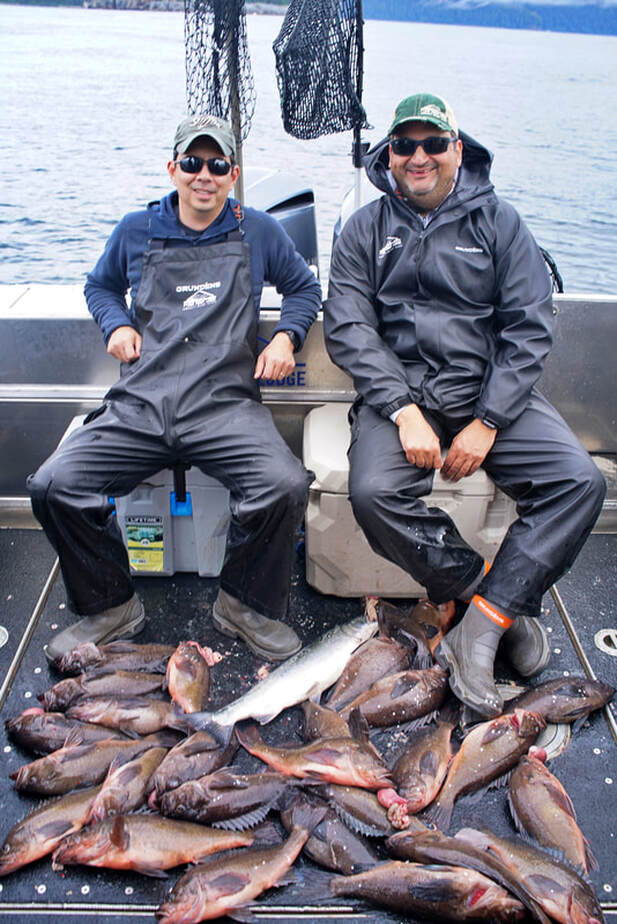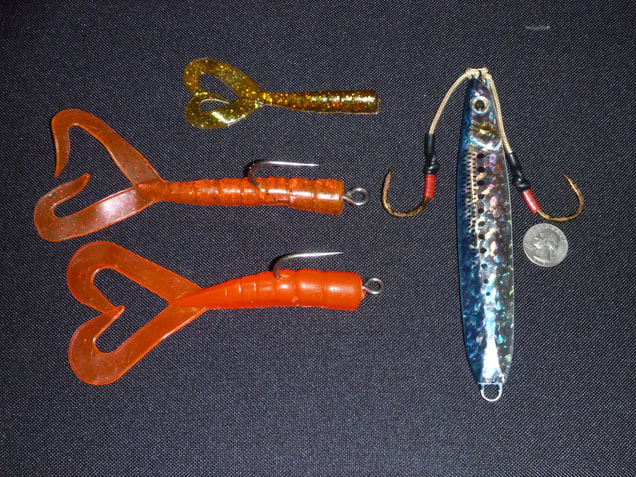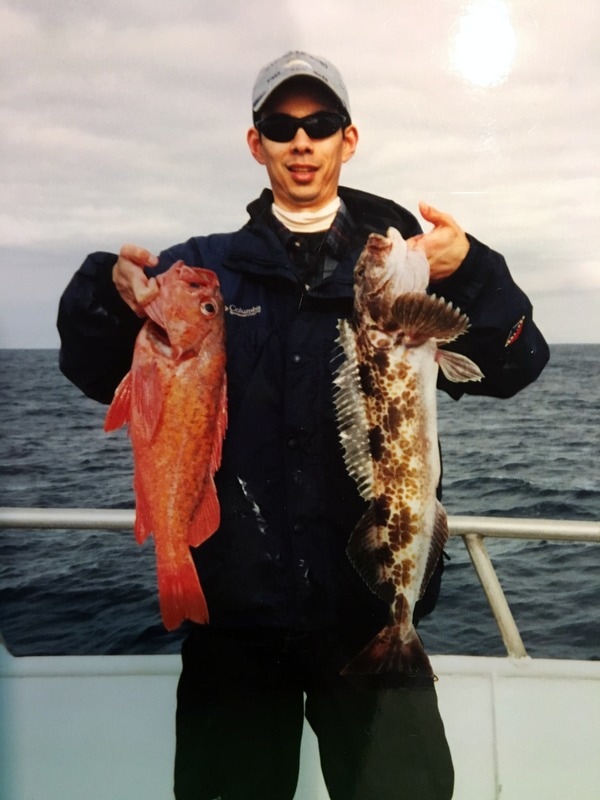Rockfish
Sebastes
HOME
Rockfish Description
Rockfish are bottom dwelling fish that are often caught in the same rocky areas as Lingcod. There are many, many species of Rockfish including Vermillion Rockfish, Copper Rockfish, Blue Rockfish, Quillback Rockfish, China Rockfish, etc. Some of them tend to stay at the bottom, while some species of Pelagic Rockfish like Black Rockfish tend to hang out in the middle of the water column. For simplicity’s sake I will lump them all together along with fish like Boccaccio and Treefish that have similar characteristics.
The great thing about fishing for Rockfish is that you never know which species you will pull up. Many of them are brightly colored and very beautiful. They don’t put up much of a fight (often when caught in deep water their air bladders expand on the way up and they are unable to fight at all) but they do taste absolutely delicious. If you are lucky enough to be able to fish for them shallow with light tackle they are a lot more sporty.
Rockfish are a great fish to get kids started on fishing because they are not usually very difficult to catch. Usually a chunk of bait sent to the bottom gets a bite right away. They don’t have big teeth but when handling them watch out for their long sharp dorsal spines.
Rockfish Pound for Pound Fight Rating - 3 out of 10 on the Saltwater Scale
Rockfish don't fight worth a darn. A few short surges and that's about it. If you are fishing deeper than about 100 feet or so, most of them will get barotrauma half way up and not fight at all from then on. Some Pelagic Rockfish such as Black Rockfish will put up a halfway decent fight on light tackle, in part because they are caught higher in the water column.
Rockfish Culinary Rating - High
What Rockfish lack in fight, they make up for in taste. There are many ways to cook them. Personally I like to deep fry them whole, but they taste good baked, steamed, grilled, and basically any other way you might want to prepare them. They have a light, delicate flesh that is typically not fishy tasting.
Rockfish Tackle
Spinning or conventional tackle should work fine. If targeting Rockfish in deep water or in heavy current you may need to use a lot of weight, which will necessitate heavier gear. It is much more fun in my opinion to target these in the shallows when possible, although often the bigger ones are found deep. Braided line is a must because its low-stretch qualities allow you to feel the bite even in deep water and make a good hookset. If you are fishing shallow you can use a light baitcasting or spinning reel to make it more sporty. When fishing deep you can use a conventional saltwater reel like an Accurate BX, although you actually don't need that good of a reel to fish for these. Even an old-school Penn Jigmaster is fine. A shorter rod will work since these are fished right on the bottom most of the time. See below for links to purchase tackle.
Rockfish Techniques
Rockfish are readily caught on both bait and lures. Once they are located they are not usually difficult to catch; it’s just a matter of dropping your lure or bait down to the bottom. Once in a while some species suspend above the bottom as well. The key most of the time in rockfishing is to use enough weight to get to the bottom quickly and stay on the bottom, especially when fishing from a drifting boat.
Below are just a few of the different species of Rockfish found in the Northeastern Pacific:
Sebastes
HOME
Rockfish Description
Rockfish are bottom dwelling fish that are often caught in the same rocky areas as Lingcod. There are many, many species of Rockfish including Vermillion Rockfish, Copper Rockfish, Blue Rockfish, Quillback Rockfish, China Rockfish, etc. Some of them tend to stay at the bottom, while some species of Pelagic Rockfish like Black Rockfish tend to hang out in the middle of the water column. For simplicity’s sake I will lump them all together along with fish like Boccaccio and Treefish that have similar characteristics.
The great thing about fishing for Rockfish is that you never know which species you will pull up. Many of them are brightly colored and very beautiful. They don’t put up much of a fight (often when caught in deep water their air bladders expand on the way up and they are unable to fight at all) but they do taste absolutely delicious. If you are lucky enough to be able to fish for them shallow with light tackle they are a lot more sporty.
Rockfish are a great fish to get kids started on fishing because they are not usually very difficult to catch. Usually a chunk of bait sent to the bottom gets a bite right away. They don’t have big teeth but when handling them watch out for their long sharp dorsal spines.
Rockfish Pound for Pound Fight Rating - 3 out of 10 on the Saltwater Scale
Rockfish don't fight worth a darn. A few short surges and that's about it. If you are fishing deeper than about 100 feet or so, most of them will get barotrauma half way up and not fight at all from then on. Some Pelagic Rockfish such as Black Rockfish will put up a halfway decent fight on light tackle, in part because they are caught higher in the water column.
Rockfish Culinary Rating - High
What Rockfish lack in fight, they make up for in taste. There are many ways to cook them. Personally I like to deep fry them whole, but they taste good baked, steamed, grilled, and basically any other way you might want to prepare them. They have a light, delicate flesh that is typically not fishy tasting.
Rockfish Tackle
Spinning or conventional tackle should work fine. If targeting Rockfish in deep water or in heavy current you may need to use a lot of weight, which will necessitate heavier gear. It is much more fun in my opinion to target these in the shallows when possible, although often the bigger ones are found deep. Braided line is a must because its low-stretch qualities allow you to feel the bite even in deep water and make a good hookset. If you are fishing shallow you can use a light baitcasting or spinning reel to make it more sporty. When fishing deep you can use a conventional saltwater reel like an Accurate BX, although you actually don't need that good of a reel to fish for these. Even an old-school Penn Jigmaster is fine. A shorter rod will work since these are fished right on the bottom most of the time. See below for links to purchase tackle.
Rockfish Techniques
Rockfish are readily caught on both bait and lures. Once they are located they are not usually difficult to catch; it’s just a matter of dropping your lure or bait down to the bottom. Once in a while some species suspend above the bottom as well. The key most of the time in rockfishing is to use enough weight to get to the bottom quickly and stay on the bottom, especially when fishing from a drifting boat.
Below are just a few of the different species of Rockfish found in the Northeastern Pacific:
Rockfish Lures
Metal jigs can be deadly on Rockfish and often result in bigger fish. If you are fishing deep or in heavy current you want a jig that will drop straight down. If you are fishing in shallower water you can afford to use a jig like a diamond jig that has a little action. Whatever; these fish aren’t that picky.
Plastic lures such as scampi tails can work well. You can fish these on whatever size leadhead gets you to the bottom or you can fish them on dropper loops.
Rockfish also frequently hit hooks dressed with bucktail or similar material.
Rockfish often bite octopus type lures such as the Lucanus jig from Shimano. Drop it to the bottom and slowly jig it up and down, pausing often. There are a number of knock-offs that work well if you don't want to spring for the Lucanus jigs which can be pretty pricey to lose.
I like to add a strip of squid to my lures to add to the appeal.
Metal jigs can be deadly on Rockfish and often result in bigger fish. If you are fishing deep or in heavy current you want a jig that will drop straight down. If you are fishing in shallower water you can afford to use a jig like a diamond jig that has a little action. Whatever; these fish aren’t that picky.
Plastic lures such as scampi tails can work well. You can fish these on whatever size leadhead gets you to the bottom or you can fish them on dropper loops.
Rockfish also frequently hit hooks dressed with bucktail or similar material.
Rockfish often bite octopus type lures such as the Lucanus jig from Shimano. Drop it to the bottom and slowly jig it up and down, pausing often. There are a number of knock-offs that work well if you don't want to spring for the Lucanus jigs which can be pretty pricey to lose.
I like to add a strip of squid to my lures to add to the appeal.
Rockfish Baits
Most small baitfish such as anchovies or sardines will work well for Rockfish. Live is best but dead bait often works. Strips of squid also work well. I'm sure lots of other baits like octopus would work well but there is no need to get fancy.
When fishing for Rockfish with bait I rarely use a bare hook; I usually use the bucktail flies or some other lure. That way if the fish pull the bait off the hook you still have a chance of hooking something.
Where to get the big Rockfish
Alaska is a great spot for huge Rockfish. They take a back seat to the “glamour” species such as Salmon and Halibut up there but if you want to catch the biggest Rockfish that is the place. The Big Sur area near Morro Bay, California also holds some huge Rockfish. There are also some good spots in the Pacific Northwest.
Barotrauma
Many Rockfish suffer from barotrauma when being reeled in. Barotrauma is damage to tissue caused by a rapid change in pressure. Fish that have swim bladders are susceptible to it, especially if hooked deep as Rockfish often are. Far too many times a Rockfish that cannot be kept is thrown back with an expanded swim bladder and floats around until it dies. Whenever possible, Rockfish should be released in a way that gives them a chance to survive. You can deflate the swim bladder with a needle to give them a chance to swim back down, or even better there are special cages that you can put the fish into and drop them back down to the bottom to release them with a better chance of survival. If you fish often for Rockfish, it is worth familiarizing yourself with proper release methods.
Other Rockfish Resources
The above barely scratches the surface on how to catch Rockfish. The resources below will provide a wealth of information:
Nice article on Rockfish: http://www.songslinger.net/rockfish.htm
This site has several good articles: http://www.fishsniffer.com/guest/jmrocfishpart2.html
Ronnie Kovach's book Saltwater Fishing in California is also a good resource.
Most small baitfish such as anchovies or sardines will work well for Rockfish. Live is best but dead bait often works. Strips of squid also work well. I'm sure lots of other baits like octopus would work well but there is no need to get fancy.
When fishing for Rockfish with bait I rarely use a bare hook; I usually use the bucktail flies or some other lure. That way if the fish pull the bait off the hook you still have a chance of hooking something.
Where to get the big Rockfish
Alaska is a great spot for huge Rockfish. They take a back seat to the “glamour” species such as Salmon and Halibut up there but if you want to catch the biggest Rockfish that is the place. The Big Sur area near Morro Bay, California also holds some huge Rockfish. There are also some good spots in the Pacific Northwest.
Barotrauma
Many Rockfish suffer from barotrauma when being reeled in. Barotrauma is damage to tissue caused by a rapid change in pressure. Fish that have swim bladders are susceptible to it, especially if hooked deep as Rockfish often are. Far too many times a Rockfish that cannot be kept is thrown back with an expanded swim bladder and floats around until it dies. Whenever possible, Rockfish should be released in a way that gives them a chance to survive. You can deflate the swim bladder with a needle to give them a chance to swim back down, or even better there are special cages that you can put the fish into and drop them back down to the bottom to release them with a better chance of survival. If you fish often for Rockfish, it is worth familiarizing yourself with proper release methods.
Other Rockfish Resources
The above barely scratches the surface on how to catch Rockfish. The resources below will provide a wealth of information:
Nice article on Rockfish: http://www.songslinger.net/rockfish.htm
This site has several good articles: http://www.fishsniffer.com/guest/jmrocfishpart2.html
Ronnie Kovach's book Saltwater Fishing in California is also a good resource.

A simple device like this can be used to release Rockfish down deep to help them survive barotrauma. Attach the hook to the lower jaw, and send it down on a heavy line. When it has gone down enough that you think the air bladder has deflated, give it a quick jerk to release the fish and reel the device back up.


